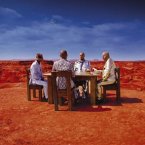Welcome to one of the most active flamenco sites on the Internet. Guests can read most posts but if you want to participate click here to register.
This site is dedicated to the memory of Paco de Lucía, Ron Mitchell, Guy Williams, Linda Elvira, Philip John Lee, Craig Eros, Ben Woods, David Serva and Tom Blackshear who went ahead of us.
We receive 12,200 visitors a month from 200 countries and 1.7 million page impressions a year. To advertise on this site please contact us.
|

|
|
Practice technique
|
You are logged in as Guest
|
|
Users viewing this topic: none
|
|
Login  | |
|

   
Miguel de Maria
Posts: 3532
Joined: Oct. 20 2003
From: Phoenix, AZ

|
 Practice technique Practice technique
|
|
|
I've been having problems with a certain passage in Panaderos Flamencos. It's a first position A scale, starting at the C# on the 2nd string (2nd fret, 2nd string), going up to the A on the E string, (fifth fret, 1st string), and then going way back down to the sixth string and ending up on the A. Really just a big scale back and forth. But I've been having such problems!
One of my partners in music, Arturo, shared with me a practice technique. He diagnosed my problem of basic unfamiliarity with the motions, especially as they lined up with the rhythm. What does that mean? I knew the scale back and forth; I've been practicing this lick for 6 months. But I didn't have a true knowledge of the downbeats. I would play this long, sixtheenth-note scale, but it wouldn't sound good and I would get lost. I would often flub the first note on the fourth string, in a string crossing situation.
So the most obvious problem was I would mess up the scale.
The next layer showed that my downbeats did not connect with the correct downbeats--I was wandering.
Also, there was a spot--usually when my a or middle finger had to reach up while going from the third string to the fourth string--where things would fall apart.
The solution was to break it up into beats and match it up with the rhythm. I would play the first group of sixteenth notes, ta ka ta ka ta, rest, ta ka ta ka ta, rest, ta ka ta ka ta, rest... then move on to the second group.. ta ka ta ka ta, rest, ta ka ta ka ta, rest, so on and so forth.
Eventually it was shown that the fifth beat was my sticking point. So I paid especial attention there, over and over ta ka ta ka ta, just that one beat. I could feel my fingers start to get in line... they had been confused in this long lick.. by the time they got to this part of it, they were lost. Add that to the string crossing challenge and that's why I couldn't get past it.
The sixth beat was similiar and I had to work on that a lot too.
After isolating individual beats, they would be strung togther: ta ka ta ka ta ka ta ka ta, ta ka ta ka ta ka ta ka ta, etc. in twos, threes, and finally the whole lick.
After about 15 minutes of this and coaching from Arturo, he said, "play the whole thing!" and amazingly, the whole lick came out smooth and sharp.
I'll need probably a few days of special treatment to get everything ironed out, to re-program myself. After messing it up so many times, of course, you program your fingers to mess up. They become very well trained and messing up. This kind of intensive training can help change. Merely because breaking it down to beats means getting it to a unit you can deal with. If you can deal with it, then you can start programming yourself to succeed.
|
|
|
|
REPORT THIS POST AS INAPPROPRIATE |
Date Nov. 21 2003 22:50:34
 |
|

   
Jon Boyes
Posts: 1377
Joined: Jul. 10 2003

|
 RE: Practice technique (in reply to Miguel de Maria) RE: Practice technique (in reply to Miguel de Maria)
|
|
|
quote:
ORIGINAL: Miguel de Maria
The solution was to break it up into beats and match it up with the rhythm. I would play the first group of sixteenth notes, ta ka ta ka ta, rest, ta ka ta ka ta, rest, ta ka ta ka ta, rest... then move on to the second group.. ta ka ta ka ta, rest, ta ka ta ka ta, rest, so on and so forth.
Miguel
This sounds a bit like Scott Tenant's tips for long scale runs. He recommends adding accents at the start of every natural grouping of notes, so that the scale is broken down into more manageable chunks mentally, then removing these accents later. For example, intead of seeing a whole bar of sixteenth notes as dah-dah-dah-dah etc, you could add accents at the star of every beat while you practice it: DAH-dah-dah-da-DAH-dah-dah-dah...etc. Depending on the music, it may be benefical to add the accents in groups of sixes or whatever.
I found this to be very useful with some of PDL's runs I'm working on.
Cheers
Jon
|
|
|
|
REPORT THIS POST AS INAPPROPRIATE |
Date Nov. 24 2003 12:55:23
 |
|
 New Messages New Messages |
 No New Messages No New Messages |
 Hot Topic w/ New Messages Hot Topic w/ New Messages |
 Hot Topic w/o New Messages Hot Topic w/o New Messages |
 Locked w/ New Messages Locked w/ New Messages |
 Locked w/o New Messages Locked w/o New Messages |
|
 Post New Thread
Post New Thread
 Reply to Message
Reply to Message
 Post New Poll
Post New Poll
 Submit Vote
Submit Vote
 Delete My Own Post
Delete My Own Post
 Delete My Own Thread
Delete My Own Thread
 Rate Posts
Rate Posts
|
|
|
Forum Software powered by ASP Playground Advanced Edition 2.0.5
Copyright © 2000 - 2003 ASPPlayground.NET |
0.0625 secs.
|


 Printable Version
Printable Version









 New Messages
New Messages No New Messages
No New Messages Hot Topic w/ New Messages
Hot Topic w/ New Messages Hot Topic w/o New Messages
Hot Topic w/o New Messages Locked w/ New Messages
Locked w/ New Messages Locked w/o New Messages
Locked w/o New Messages Post New Thread
Post New Thread